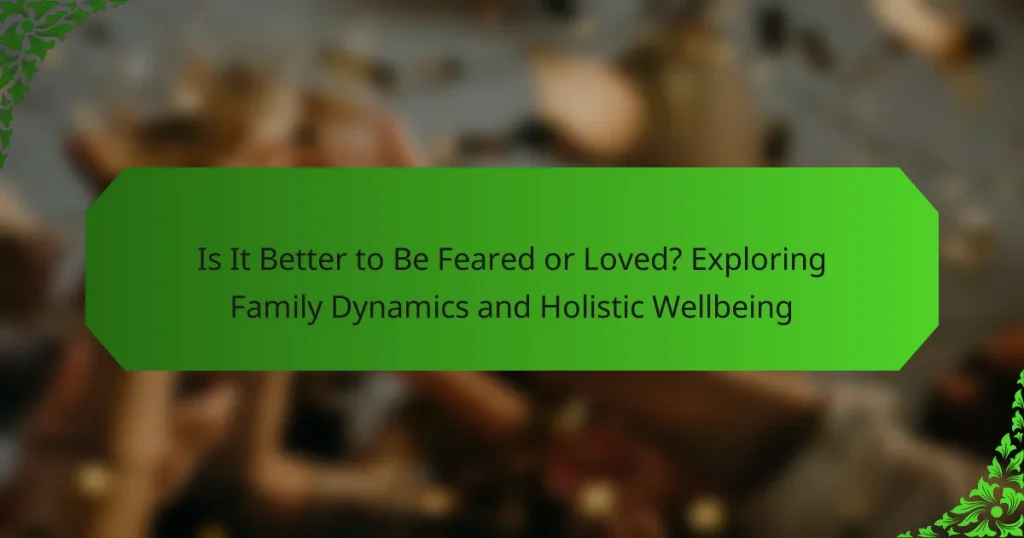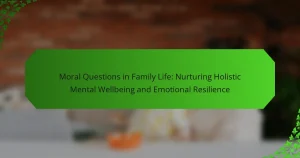Navigating family dynamics often raises the question: is it better to be feared or loved? Love fosters emotional security and open communication, while fear may lead to compliance but can damage relationships. This article explores the impact of love versus fear on family interactions, the attributes of holistic mental wellbeing, and practical strategies for improving family dynamics. Understanding these factors is essential for cultivating a supportive environment that enhances overall wellbeing.
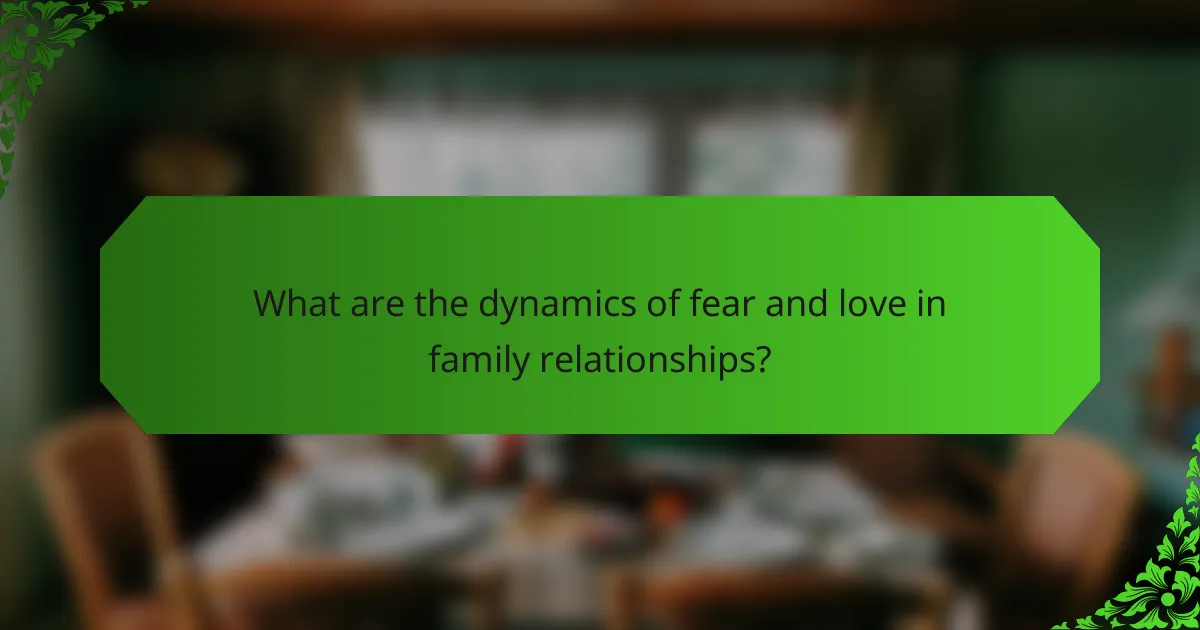
What are the dynamics of fear and love in family relationships?
In family relationships, love fosters emotional security, while fear can create compliance but often leads to resentment. Love promotes open communication, enhancing trust and connection. In contrast, fear may suppress expression, damaging relationships over time. Balancing these dynamics is crucial for holistic wellbeing. Families that prioritize love tend to experience stronger bonds and healthier interactions, ultimately leading to a more supportive environment.
How do fear and love influence parental authority?
Fear can create compliance, while love fosters trust and emotional connection in parental authority. Balancing both influences is crucial for effective parenting. Research shows that children thrive in environments where love predominates, enhancing their emotional wellbeing and resilience. In contrast, excessive fear can lead to anxiety and rebellion, undermining authority. A unique attribute of parental authority is its dual nature; love nurtures cooperation, while fear can enforce discipline. Ultimately, love is more beneficial for holistic family dynamics and long-term wellbeing.
What role does communication play in family dynamics?
Communication is crucial in family dynamics as it fosters understanding and connection. Effective communication enhances emotional support, resolves conflicts, and builds trust among family members. Studies indicate that families with open communication tend to experience higher levels of cohesion and wellbeing. Additionally, unique attributes such as active listening and empathy play significant roles in strengthening familial bonds. As a result, families that prioritize communication often navigate challenges more successfully, promoting holistic wellbeing.
What are effective communication strategies for families?
Effective communication strategies for families include active listening, open dialogue, and expressing empathy. These approaches foster trust and understanding, enhancing family dynamics. For example, active listening involves fully concentrating on the speaker, which can improve emotional connections. Open dialogue encourages family members to share thoughts without fear of judgment, while empathy allows for recognizing and validating each other’s feelings. Implementing these strategies can significantly contribute to holistic wellbeing within the family unit.
How can families balance authority and affection?
Balancing authority and affection in families is essential for healthy dynamics. Families thrive when authority is exercised with empathy, allowing children to feel secure and loved. This balance fosters trust and respect, promoting holistic wellbeing. Establishing clear boundaries alongside open communication nurtures both discipline and emotional connection.

What are the universal attributes of holistic mental wellbeing?
Holistic mental wellbeing encompasses various universal attributes that contribute to overall health. These attributes include emotional balance, social connections, physical health, purpose in life, and resilience. Each of these aspects plays a critical role in fostering a comprehensive sense of wellbeing. Emotional balance allows individuals to navigate stress effectively, while strong social connections provide support and enhance happiness. Physical health directly influences mental clarity and energy levels. A sense of purpose drives motivation and fulfillment, and resilience enables individuals to cope with challenges. Together, these attributes create a foundation for holistic mental wellbeing.
How does emotional intelligence contribute to family wellbeing?
Emotional intelligence significantly enhances family wellbeing by fostering communication and empathy. It allows family members to understand and manage their emotions, leading to healthier relationships. Families with high emotional intelligence often experience reduced conflict and increased support. This contributes to a nurturing environment, promoting overall family cohesion and resilience.
What are common practices for fostering mental wellness in families?
Fostering mental wellness in families involves open communication, emotional support, and shared activities. These practices create a nurturing environment that promotes holistic wellbeing. Regular family meetings encourage sharing feelings and resolving conflicts. Engaging in joint activities, like cooking or outdoor adventures, strengthens bonds. Prioritizing mental health through mindfulness or therapy can also enhance family dynamics.
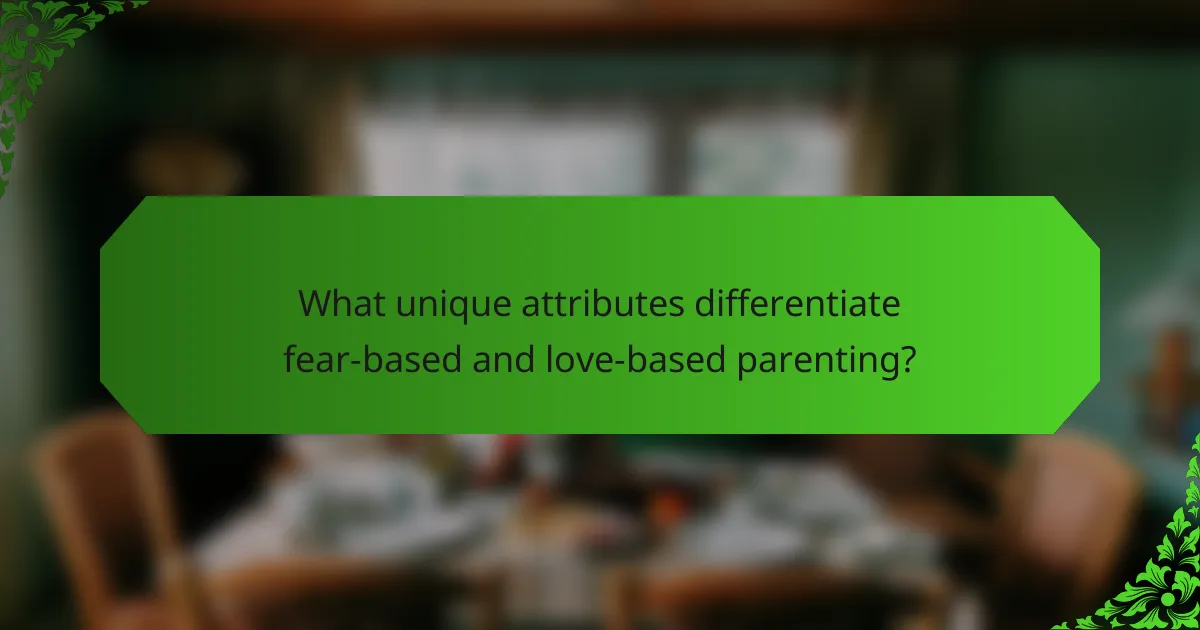
What unique attributes differentiate fear-based and love-based parenting?
Fear-based parenting often leads to obedience through intimidation, while love-based parenting fosters trust and emotional security. Unique attributes of fear-based parenting include reliance on punishment and control, whereas love-based parenting emphasizes communication and empathy. Research indicates that love-based approaches promote healthier psychological development in children. In contrast, fear-based methods may result in anxiety and rebellion, ultimately harming family dynamics.
How do parenting styles affect children’s emotional development?
Parenting styles significantly shape children’s emotional development. Authoritative parenting fosters emotional intelligence, while authoritarian styles may hinder it. Studies show that children raised with warmth and structure exhibit better emotional regulation and resilience. In contrast, overly strict approaches can lead to anxiety and low self-esteem. Understanding these dynamics is crucial for promoting holistic wellbeing in family environments.
What are the long-term effects of fear versus love in family settings?
Fear can lead to long-term emotional distress, while love fosters resilience and strong family bonds. Fear often results in anxiety, mistrust, and communication breakdowns. In contrast, love nurtures emotional security, encouraging open dialogue and emotional expression. Studies show that families rooted in love have better mental health outcomes and stronger relationships. Ultimately, love promotes holistic wellbeing, while fear creates lasting negative impacts on family dynamics.
How can families transition from fear-based to love-based dynamics?
Transitioning from fear-based to love-based family dynamics involves cultivating open communication, empathy, and trust. Families can achieve this by actively practicing positive reinforcement, setting healthy boundaries, and engaging in shared activities that foster connection.
Encouraging emotional expression allows family members to feel safe and valued. Implementing regular family meetings can facilitate discussions about feelings and conflicts, promoting a supportive environment.
Additionally, modeling love-based behaviors, such as kindness and understanding, reinforces these dynamics. As a result, families can create a nurturing atmosphere that enhances holistic wellbeing and strengthens relationships.
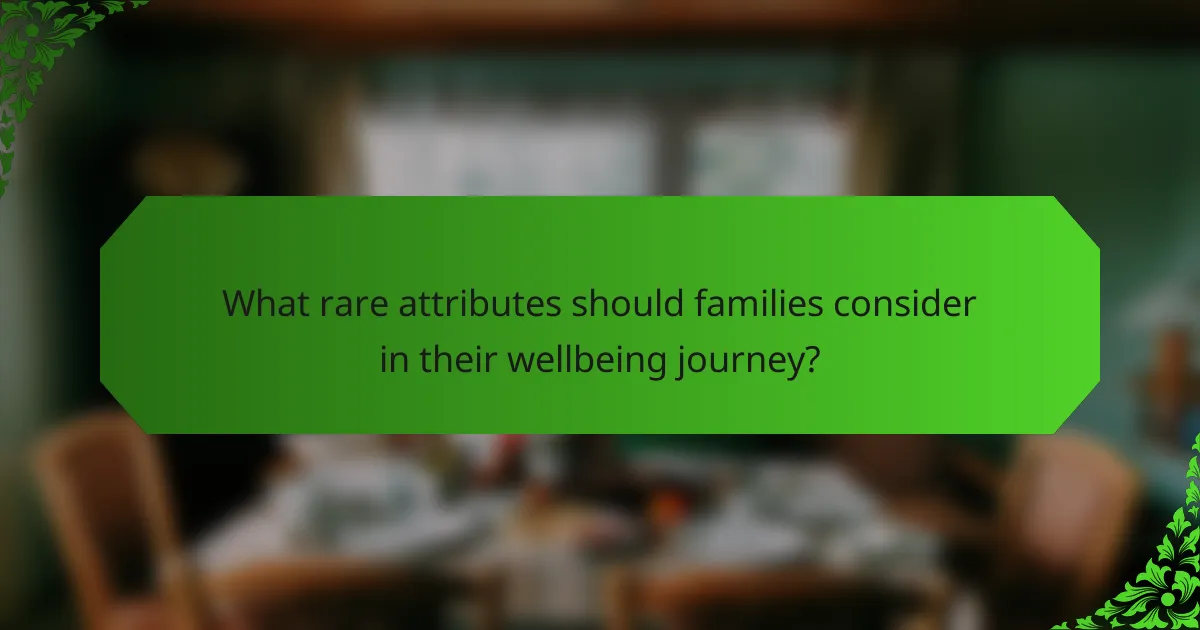
What rare attributes should families consider in their wellbeing journey?
Families should consider unique attributes like emotional intelligence, resilience, and adaptability in their wellbeing journey. These factors enhance interpersonal relationships and foster a supportive environment. Emotional intelligence allows families to navigate conflicts effectively, while resilience helps them cope with challenges. Adaptability ensures families can adjust to changing circumstances, promoting overall harmony. Prioritizing these attributes can lead to a more cohesive family unit and improved holistic wellbeing.
How can cultural influences shape perceptions of fear and love?
Cultural influences significantly shape perceptions of fear and love, often dictating how individuals express and experience these emotions. In collectivist cultures, love may be intertwined with familial duty, while fear can stem from societal expectations. Conversely, in individualistic cultures, love often emphasizes personal fulfillment, and fear may arise from personal failures. These dynamics impact family interactions and overall wellbeing, highlighting the complex relationship between cultural context and emotional expression.
What uncommon practices enhance holistic mental wellbeing?
Uncommon practices that enhance holistic mental wellbeing include nature immersion, expressive arts therapies, and community storytelling. These approaches foster deep connections, creativity, and shared experiences, contributing to a balanced mental state. Engaging with nature can reduce stress and improve mood. Expressive arts therapies allow individuals to process emotions creatively, while community storytelling builds a sense of belonging and support. Integrating these practices into daily life can significantly enhance overall mental health.
What role does community support play in family dynamics?
Community support significantly enhances family dynamics by fostering emotional resilience and social cohesion. Strong community ties provide families with resources, guidance, and a sense of belonging. For instance, families with active community engagement report higher levels of satisfaction and stability. This holistic support can mitigate stressors, improve communication, and promote well-being. Additionally, community involvement encourages shared values and mutual respect, which are essential for healthy family relationships.
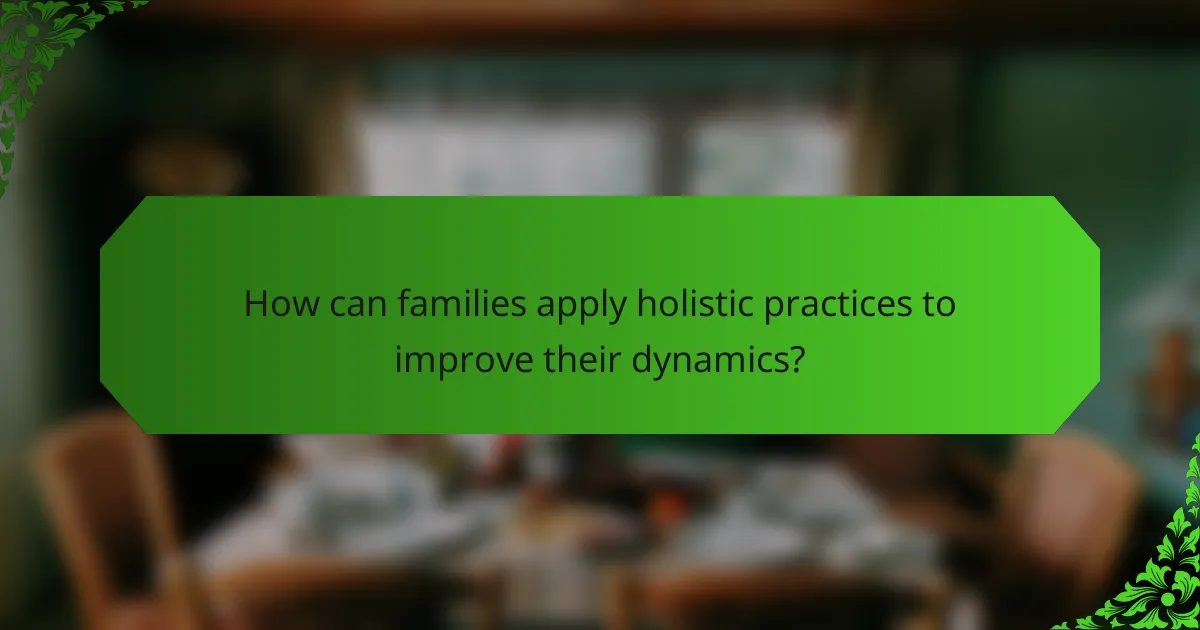
How can families apply holistic practices to improve their dynamics?
Families can apply holistic practices to improve their dynamics by fostering open communication, promoting emotional awareness, and engaging in shared activities. These practices enhance relationships and create a supportive environment. Regular family meetings can facilitate discussions about feelings and concerns, strengthening connections. Mindfulness activities, such as meditation or yoga, can improve emotional regulation and resilience. Additionally, participating in creative projects together can build teamwork and understanding. By integrating these holistic approaches, families can cultivate healthier dynamics and greater well-being.
What are the best practices for integrating love into family governance?
Integrating love into family governance fosters trust and cooperation. Prioritize open communication to express feelings and needs. Establish family rituals that reinforce connection, such as regular family meetings or shared activities. Encourage empathy by modeling understanding and support during conflicts. Lastly, create a safe environment where all members feel valued and heard, enhancing overall family dynamics and holistic wellbeing.
What common mistakes do families make in their approach to wellbeing?
Families often make mistakes in their approach to wellbeing by prioritizing control over emotional connection. Common errors include neglecting open communication, failing to establish healthy boundaries, and emphasizing discipline over support. These missteps can hinder emotional growth and create tension. Families should focus on fostering trust and understanding to enhance holistic wellbeing.
How can families measure their emotional health effectively?
Families can measure their emotional health effectively through regular communication, emotional check-ins, and shared activities. These practices foster openness and connection.
1. Schedule regular family meetings to discuss feelings and concerns.
2. Implement emotional check-ins where each member shares their current emotional state.
3. Engage in shared activities that promote bonding, such as family outings or game nights.
4. Utilize tools like mood journals to track emotional changes over time.
5. Seek professional guidance if emotional health issues persist.
These strategies enhance family dynamics and contribute to holistic wellbeing.
What expert insights can guide families toward healthier dynamics?
To foster healthier family dynamics, prioritize love over fear. Research shows that loving environments enhance emotional security, leading to better communication and conflict resolution. Establishing trust and open dialogue encourages family members to express their feelings without fear of retribution. Additionally, engaging in shared activities can strengthen bonds and promote holistic wellbeing. Families that practice empathy and understanding create supportive atmospheres, which contribute to overall mental health.
